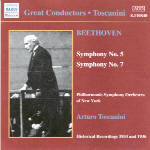Hearing these classic recordings (the Fifth was never officially authorized for release and therefore is not to be found in RCA’s Toscanini Edition) begs the obvious question: do they still deserve their “legendary” status? On the whole, they do. The Fifth, which was recorded live in Carnegie Hall on April 9, 1933, offers playing of astonishing quality and perhaps even more than the Seventh reveals the intensity, rhythmic control, and sheer orchestral splendor that were almost (at this period in any case) uniquely Toscanini’s. Certainly there was no finer recorded conception of this symphony (save his own remakes) until Erich Kleiber came along in the ’50s, and that includes Furtwängler, who matched Toscanini in grandeur and breadth of interpretation (especially in the finale) but commanded neither comparable orchestral discipline nor such depth of sonority from top to bottom.
Since its recording in 1936, the Seventh has been acclaimed as a benchmark–though not without some controversy. Toscanini has a reputation as a “fast” conductor, but those who believe, for example, that the finale of this symphony should be whipped up into a hysterical frenzy are likely to be disappointed. In fact, what animates this performance more than sheer speed is an intense lyricism allied to tight rhythmic control. The modern version that comes closest to Toscanini’s conception is Günter Wand’s, who openly acknowledges his indebtedness to his great predecessor. Some listeners might well prefer a performance that offers more abandon and a greater sense of danger, but there’s no denying Toscanini’s ability to make the music sing, and to sculpt each movement with impressive inevitability. Besides, to acclaim any performance as “the one” for all time is to deny the work’s status as a classic capable of near infinite renewal through varying interpretive perspectives. Of its type, this version is magnificent, but there are other approaches (Furtwängler’s, Bernstein’s, Blomstedt’s) that offer just as compelling a listening experience in their different ways.
Naxos intelligently offers two alternatives for the Seventh’s first movement, reflecting both the original issue and the substituted second take for Side 1 of the first 78 rpm edition. The second take is marginally faster and slightly more disciplined, but there’s little to choose between them. Mark Obert-Thorn’s transfer of the Fifth sounds terrific: clear and full despite the inevitable limitations of dynamic range. His work on the Seventh, however, does not quite equal Ward Marston’s transfer in RCA’s Toscanini Edition in A/B comparisons. The latter offers a more open top and a touch more presence, albeit with more surface noise. Still, the differences are small, and since RCA doesn’t include the Fifth or the Seventh’s alternate take, I can certainly understand any listener preferring this first disc in what promises to be a complete survey of Toscanini’s New York Philharmonic recordings.
































